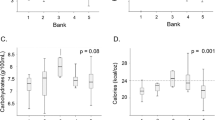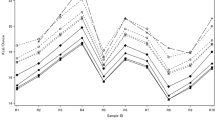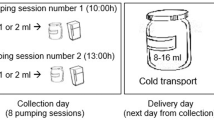Abstract
Objective:
Nutrient composition of human milk (HM) is highly variable. Targeted HM fortification has been proposed to address these variations and reduce the cumulative nutritional deficit in preterm infants. Near-infrared analysis is used to measure the protein and fat content in HM; however, the reliability of this technique has not been evaluated. The objective of this study is to evaluate the reproducibility and accuracy of two generations of HM analyzers (HMA1 and HMA2) in estimating protein and lipid contents.
Study Design:
Reproducibility was assessed by analyzing in duplicate 146 and 128 HM samples with HMA1 and HMA2 (Miris), respectively. To evaluate the accuracy, lipid and protein concentrations were assessed in 31 and 39 samples using HMA1 or HMA2, respectively. Values were compared with measurements obtained using reference methods and correction equations were calculated. After applying the correction equations on 12 HM samples, the performance of the two devices were compared and the equation was validated according to the reference methods.
Results:
The coefficients of variation for protein and lipid assessments were below 3% for both HMA1 and HMA2. Protein concentrations were significantly underestimated by HMA2 (−0.53±0.23 g dl−1). Lipid content was significantly overestimated by both devices, but the error was greater with HMA1 (0.76±0.48 g dl−1) than with HMA2 (0.36±0.33 g dl−1). Correction equations were specific for each generation of HMA. Finally, after correction, both instruments provided similar and accurate results.
Conclusion:
HMAs require calibration adjustment before their use in clinical practice, to avoid inappropriate HM fortification.
This is a preview of subscription content, access via your institution
Access options
Subscribe to this journal
Receive 12 print issues and online access
$259.00 per year
only $21.58 per issue
Buy this article
- Purchase on Springer Link
- Instant access to full article PDF
Prices may be subject to local taxes which are calculated during checkout



Similar content being viewed by others
References
Lucas A, Cole TJ . Breast milk and neonatal necrotising enterocolitis. Lancet 1990; 336 (8730): 1519–1523.
Ronnestad A . Late-onset septicemia in a Norwegian National Cohort of extremely premature infants receiving very early full human milk feeding. Pediatrics 2005; 115 (3): e269–e276.
Vohr BR, Poindexter BB, Dusick AM, McKinley LT, Higgins RD, Langer JC et al. Persistent beneficial effects of breast milk ingested in the neonatal intensive care unit on outcomes of extremely low birth weight infants at 30 months of age. Pediatrics 2007; 120 (4): e953–e959.
ESPGHAN Committee on Nutrition ESPGHAN Committee on Nutrition, Arslanoglu S, ESPGHAN Committee on Nutrition, Corpeleijn W, ESPGHAN Committee on Nutrition, Moro G, ESPGHAN Committee on Nutrition, Braegger C, ESPGHAN Committee on Nutrition, Campoy C et al. Donor human milk for preterm infants: current evidence and research directions. J Pediatr Gastroenterol Nutr 2013; 57 (4): 535–542.
Simmer K, Metcalf R, Daniels L . The use of breastmilk in a neonatal unit and its relationship to protein and energy intake and growth. J Paediatr Child Health 1997; 33 (1): 55–60.
Arslanoglu S, Moro GE, Ziegler EE . Adjustable fortification of human milk fed to preterm infants: does it make a difference? J Perinatol Off J Calif Perinat Assoc 2006; 26 (10): 614–621.
Polberger SK, Axelsson IA, Räihä NC . Growth of very low birth weight infants on varying amounts of human milk protein. Pediatr Res 1989; 25 (4): 414–419.
Weber A, Loui A, Jochum F, Bührer C, Obladen M . Breast milk from mothers of very low birthweight infants: variability in fat and protein content. Acta Paediatr 2001; 90 (7): 772–775.
Mitoulas LR, Kent JC, Cox DB, Owens RA, Sherriff JL, Hartmann PE . Variation in fat, lactose and protein in human milk over 24 h and throughout the first year of lactation. Br J Nutr 2002; 88 (01): 29.
Cooper AR, Barnett D, Gentles E, Cairns L, Simpson JH . Macronutrient content of donor human breast milk. Arch Dis Child Fetal Neonatal Ed 2013; 98 (6): F539–F541.
De Halleux V, Rigo J . Variability in human milk composition: benefit of individualized fortification in very-low-birth-weight infants. Am J Clin Nutr 2013; 98 (2): 529 S–535 S.
Polberger S, Räihä NC, Juvonen P, Moro GE, Minoli I, Warm A . Individualized protein fortification of human milk for preterm infants: comparison of ultrafiltrated human milk protein and a bovine whey fortifier. J Pediatr Gastroenterol Nutr 1999; 29 (3): 332–338.
De Halleux V, Close A, Stalport S, Studzinski F, Habibi F, Rigo J . Advantages of individualized fortification of human milk for preterm infants. Arch Pediatr 2007; 14 (Suppl 1): S5–S10.
Arslanoglu S, Moro GE, Ziegler EE, The Wapm Working Group On Nutrition. Optimization of human milk fortification for preterm infants: new concepts and recommendations. J Perinat Med 2010; 38 (3): 233–238.
Michaelsen KF, Pedersen SB, Skafte L, Jaeger P, Peitersen B . Infrared analysis for determining macronutrients in human milk. J Pediatr Gastroenterol Nutr 1988; 7 (2): 229–235.
Corvaglia L, Battistini B, Paoletti V, Aceti A, Capretti MG, Faldella G . Near-infrared reflectance analysis to evaluate the nitrogen and fat content of human milk in neonatal intensive care units. Arch Dis Child Fetal Neonatal 2008; 93 (5): F372–F375.
Sauer CW, Kim JH . Human milk macronutrient analysis using point-of-care near-infrared spectrophotometry. J Perinatol 2011; 31 (5): 339–343.
Menjo A, Mizuno K, Murase M, Nishida Y, Taki M, Itabashi K et al. Bedside analysis of human milk for adjustable nutrition strategy. Acta Paediatr 1992 2009; 98 (2): 380–384.
Casadio YS, Williams TM, Lai CT, Olsson SE, Hepworth AR, Hartmann PE . Evaluation of a mid-infrared analyzer for the determination of the macronutrient composition of human milk. J Hum Lact 2010; 26 (4): 376–383.
Silvestre D, Fraga M, Gormaz M, Torres E, Vento M . Comparison of mid-infrared transmission spectroscopy with biochemical methods for the determination of macronutrients in human milk: Human milk composition analysis. Matern Child Nutr 2014; 10 (3): 373–382.
Rochow N, Fusch G, Choi A, Chessell L, Elliott L, McDonald K et al. Target fortification of breast milk with fat, protein, and carbohydrates for preterm infants. J Pediatr 2013; 163 (4): 1001–1007.
Lynch JM, Barbano DM, Schweisthal M, Fleming JR . Precalibration evaluation procedures for mid-infrared milk analyzers. J Dairy Sci 2006; 89 (7): 2761–2774.
Fusch G, Rochow N, Choi A, Fusch S, Poeschl S, Ubah AO et al. Rapid measurement of macronutrients in breast milk: how reliable are infrared milk analyzers? Clin Nutr 2015; 34 (3): 465–476.
Règles de bonnes pratiques de collecte, de préparation, de qualification, de traitement, de conservation, de distribution et de délivrance sur prescription médicale du lait humain par les lactariums; Afssaps, Decision du 3 décembre 2007 - JO du 5 janvier 2008, English version available at http://sdp.perinat-france.org/ADLF/files/lactarium_guide_bonnes_pratiques_5_janvier_2008_traduction_anglais.pdf, Accessed 14 January 2017.
Bartlett JW, Frost C . Reliability, repeatability and reproducibility: analysis of measurement errors in continuous variables. Ultrasound Obstet Gynecol 2008; 31 (4): 466–475.
Miller EM, Aiello MO, Fujita M, Hinde K, Milligan L, Quinn EA . Field and laboratory methods in human milk research. Am J Hum Biol 2013; 25 (1): 1–11.
Passing H, Bablok W . A new biometrical procedure for testing the equality of measurements from two different analytical methods. Application of linear regression procedures for method comparison studies in clinical chemistry, Part I. J Clin Chem Clin Biochem 1983; 21 (11): 709–720.
Passing H, Bablok W . Comparison of several regression procedures for method comparison studies and determination of sample sizes. Application of linear regression procedures for method comparison studies in Clinical Chemistry, Part II. J Clin Chem Clin 1984; 22 (6): 431–445.
Bland JM, Altman DG . Statistical methods for assessing agreement between two methods of clinical measurement. Lancet 1986; 1 (8476): 307–310.
Donovan SM, Atkinson SA, Whyte RK, Lönnerdal B . Partition of nitrogen intake and excretion in low-birth-weight infants. Am J Dis Child 1989; 143 (12): 1485–1491.
Putet G, Senterre J, Rigo J, Salle B . Nutrient balance, energy utilization, and composition of weight gain in very-low-birth-weight infants fed pooled human milk or a preterm formula. J Pediatr 1984; 105 (1): 79–85.
Wojcik KY, Rechtman DJ, Lee ML, Montoya A, Medo ET . Macronutrient analysis of a nationwide sample of donor breast milk. J Am Diet Assoc 2009; 109 (1): 137–140.
Billard H, Simon L, Desnots E, Sochard A, Boscher C, Riaublanc A et al. Calibration adjustment of the mid-infrared analyzer for an accurate determination of the macronutrient composition of human milk. J Hum Lact 2015 32: NP19–NP27, pii:.
García-Lara NR, Escuder-Vieco D, García-Algar O, De la Cruz J, Lora D, Pallás-Alonso C . Effect of freezing time on macronutrients and energy content of breastmilk. Breastfeed Med 2012; 7 (4): 295–301.
Acknowledgements
We are indebted to Jocelyne Trompette and the team at the Rhône-Alpes HM bank for their help with the collection and handling of HM samples. We also thank Christelle Maurice for her help with the statistical analyses.
Author information
Authors and Affiliations
Corresponding author
Ethics declarations
Competing interests
The authors declare no conflict of interest.
Rights and permissions
About this article
Cite this article
Buffin, R., Decullier, E., De Halleux, V. et al. Assessment of human milk composition using mid-infrared analyzers requires calibration adjustment. J Perinatol 37, 552–557 (2017). https://doi.org/10.1038/jp.2016.230
Received:
Revised:
Accepted:
Published:
Issue Date:
DOI: https://doi.org/10.1038/jp.2016.230
This article is cited by
-
Comparison of macronutrient content in human milk measured by mid-infrared human milk analyzer and reference methods
Journal of Perinatology (2019)
-
Transmission infrared spectroscopy for rapid quantification of fat, protein, and lactose concentrations in human milk
Journal of Perinatology (2018)



